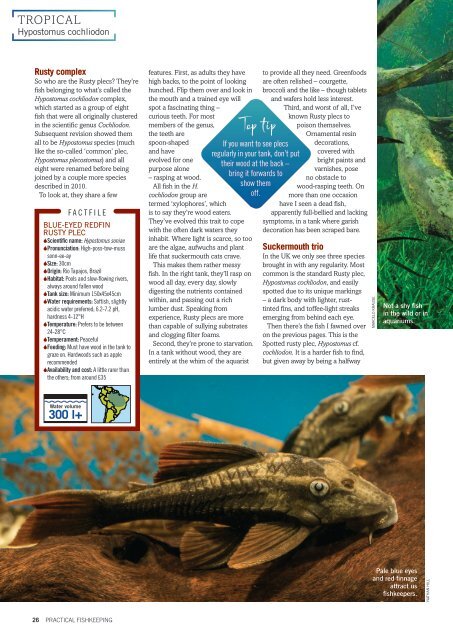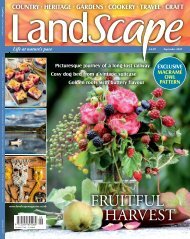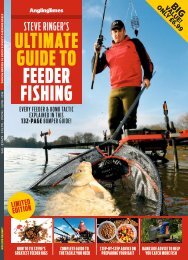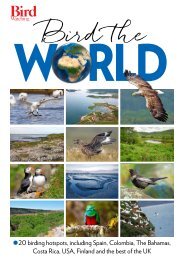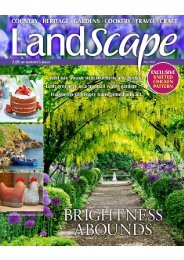Create successful ePaper yourself
Turn your PDF publications into a flip-book with our unique Google optimized e-Paper software.
TROPICAL<br />
Hypostomus cochliodon<br />
Rusty complex<br />
So who are the Rusty plecs? They’re<br />
fish belonging to what’s called the<br />
Hypostomus cochliodon complex,<br />
which started as a group of eight<br />
fish that were all originally clustered<br />
in the scientific genus Cochliodon.<br />
Subsequent revision showed them<br />
all to be Hypostomus species (much<br />
like the so-called ‘common’ plec,<br />
Hypostomus plecostomus) and all<br />
eight were renamed before being<br />
joined by a couple more species<br />
described in 2010.<br />
To look at, they share a few<br />
Factfile<br />
Blue-eyed redfin<br />
rusty plec<br />
Scientific name: Hypostomus soniae<br />
Pronunciation: High-poss-tow-muss<br />
sonn-ee-ay<br />
Size: 30cm<br />
Origin: Rio Tapajos, Brazil<br />
Habitat: Pools and slow-flowing rivers,<br />
always around fallen wood<br />
Tank size: Minimum 150x45x45cm<br />
Water requirements: Softish, slightly<br />
acidic water preferred; 6.2-7.2 pH,<br />
hardness 4-12°H<br />
Temperature: Prefers to be between<br />
24-28°C<br />
Temperament: Peaceful<br />
Feeding: Must have wood in the tank to<br />
graze on. Hardwoods such as apple<br />
recommended<br />
Availability and cost: A little rarer than<br />
the others; from around £35<br />
features. First, as adults they have<br />
high backs, to the point of looking<br />
hunched. Flip them over and look in<br />
the mouth and a trained eye will<br />
spot a fascinating thing –<br />
curious teeth. For most<br />
members of the genus,<br />
the teeth are<br />
spoon-shaped<br />
and have<br />
evolved for one<br />
purpose alone<br />
– rasping at wood.<br />
All fish in the H.<br />
cochliodon group are<br />
termed ‘xylophores’, which<br />
is to say they’re wood eaters.<br />
They’ve evolved this trait to cope<br />
with the often dark waters they<br />
inhabit. Where light is scarce, so too<br />
are the algae, aufwuchs and plant<br />
life that suckermouth cats crave.<br />
This makes them rather messy<br />
fish. In the right tank, they’ll rasp on<br />
wood all day, every day, slowly<br />
digesting the nutrients contained<br />
within, and passing out a rich<br />
lumber dust. Speaking from<br />
experience, Rusty plecs are more<br />
than capable of sullying substrates<br />
and clogging filter foams.<br />
Second, they’re prone to starvation.<br />
In a tank without wood, they are<br />
entirely at the whim of the aquarist<br />
If you want to see plecs<br />
regularly in your tank, don’t put<br />
their wood at the back –<br />
bring it forwards to<br />
show them<br />
off.<br />
to provide all they need. Greenfoods<br />
are often relished – courgette,<br />
broccoli and the like – though tablets<br />
and wafers hold less interest.<br />
Third, and worst of all, I’ve<br />
known Rusty plecs to<br />
poison themselves.<br />
Ornamental resin<br />
decorations,<br />
covered with<br />
bright paints and<br />
varnishes, pose<br />
no obstacle to<br />
wood-rasping teeth. On<br />
more than one occasion<br />
have I seen a dead fish,<br />
apparently full-bellied and lacking<br />
symptoms, in a tank where garish<br />
decoration has been scraped bare.<br />
Suckermouth trio<br />
In the UK we only see three species<br />
brought in with any regularity. Most<br />
common is the standard Rusty plec,<br />
Hypostomus cochliodon, and easily<br />
spotted due to its unique markings<br />
– a dark body with lighter, rusttinted<br />
fins, and toffee-light streaks<br />
emerging from behind each eye.<br />
Then there’s the fish I fawned over<br />
on the previous pages. This is the<br />
Spotted rusty plec, Hypostomus cf.<br />
cochliodon. It is a harder fish to find,<br />
but given away by being a halfway<br />
marcelo Krause<br />
Not a shy fish<br />
in the wild or in<br />
aquariums.<br />
300 l+<br />
Pale blue eyes<br />
and red finnage<br />
attract us<br />
fishkeepers.<br />
nathan hill<br />
26 PRACTICAL FISHKEEPING


